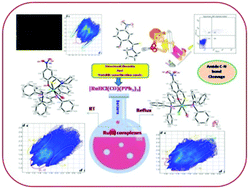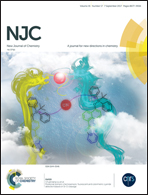Versatile coordination ability of thioamide ligand in Ru(ii) complexes: synthesis, computational studies, in vitro anticancer activity and apoptosis induction†
Abstract
The reaction of a (2-hydroxy-5-nitrophenyl)(pyrrolidin-1-yl) methanethione ligand (L), with an equimolar amount of [RuHCl(CO)(PPh3)3] afforded two structurally different ruthenium(II) complexes of formulas [Ru(CO)(Cl)(PPh3)2(O^S)] (1) and [Ru(CO)(PPh3)2(N^O^S)] (2) by varying the experimental reactions conditions. Interestingly, the ligand behaves in a monobasic bidendate OS fashion in reflux conditions vis C–N bond cleavage, while it acts as a dibasic tridendate NOS donor at room temperature towards the ruthenium(II) precursor. The synthesised ruthenium complexes 1 and 2 are fully characterized by means of analytical (elemental analysis), spectral [FT-IR, UV-vis, NMR (1H, 13C and 31P)] and fluorescence methods, respectively. The solid state molecular structures of the ligand and the complexes were studied by using single crystal X-ray crystallography, which confirms the different coordination mode of the ligand with the ruthenium ion and reveals the presence of distorted octahedral geometry. Notably, in complex 1, the two triphenylphosphine co-ligands occupy trans positions, whereas in complex 2 they are mutually cis disposed. The intercontacts in the crystal structures are examined using Hirshfeld surface analysis. The stability of the complexes is also studied by time-dependent UV-visible and ESI-mass spectral methods. Moreover, the cytotoxic effect of the complexes is examined on cancerous cell lines such as HeLa and MCF-7 along with a cell viability assay against non-cancerous NIH-3T3 cells under in vitro conditions and the results showed that the complexes exhibit significant anticancer activity. Furthermore, the morphological changes and apoptosis induction have been studied by AO-EB dual staining methods, Hoechst 33258 and flow cytometry techniques.



 Please wait while we load your content...
Please wait while we load your content...